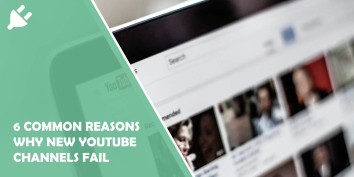The lifeblood of any business is the ability for customers to find you. Search Engine…
Have you ever felt like your PPC leads are slipping through your fingers like sand? It can be frustrating to invest in pay-per-click advertising, only to find that it’s not translating into actual sales or conversions. But fear not! In this article, we will dive deep into the underlying factors behind this issue and unveil 5 compelling reasons why your PPC leads are failing to convert. Buckle up as we unravel the secrets to boosting conversion rates and finally harnessing the full potential of your marketing efforts.
Why PPC leads are important for businesses
PPC (Pay-Per-Click) leads hold immense importance for businesses in today’s digital landscape. While generating a high volume of leads is crucial, what truly matters is their quality and conversion rate. PPC takes the guesswork out of advertising by allowing businesses to reach their target audience with laser precision. Unlike traditional advertising methods, PPC enables companies to directly engage with potential customers who are actively searching for products or services that they offer.
One significant advantage of PPC leads is the ability to track and measure their performance accurately. With detailed analytics and data-driven insights, businesses can gain a comprehensive understanding of how well their campaigns are performing, which keywords are driving the most valuable traffic, and even which ads resonate best with their audience. By constantly analyzing this information, businesses can make informed decisions to optimize their campaigns and maximize conversion rates.
Moreover, PPC leads have higher intent compared to other forms of online marketing channels like social media or display advertising. When someone clicks on a sponsored ad through a search engine or another platform, it indicates that they have already expressed interest in what the business has to offer. This intent makes PPC leads much more likely to convert into actual customers compared to passive audiences who may simply be scrolling through social media feeds without any specific purchasing intent.

Lack of targeting
One of the key reasons why your PPC leads may not be converting is a lack of targeting. Many businesses make the mistake of focusing on quantity rather than quality when it comes to their lead generation efforts. They cast a wide net and hope that something will stick, but this approach often results in poor conversion rates.
By honing in on a specific target audience and tailoring your messaging to resonate with them, you can significantly improve your chances of conversion. Take the time to research and understand who your ideal customer is, what their pain points are, and how your product or service solves their problems. This allows you to create highly targeted ads that speak directly to these potential customers and increase the likelihood that they will take action.
Furthermore, lack of targeting can also lead to wasted ad spend. When you don’t refine your targeting parameters, you end up showing ads to people who have no interest in what you have to offer. This not only wastes precious advertising dollars but also dilutes the effectiveness of your campaigns overall.
In conclusion, by taking a more targeted approach in your PPC campaigns, you can improve conversion rates and make better use of your advertising budget. By understanding who your ideal customer is and creating tailored messages for them, you increase the chances that they will convert into paying customers. Don’t fall into the trap of broad strokes – focus on quality over quantity when it comes to attracting potential buyers through PPC advertising.
Ineffective landing page design
Ineffective landing page design can be the biggest hurdle in converting PPC leads into customers. A poorly designed landing page can confuse, frustrate, and ultimately drive potential customers away. One common mistake is cluttered layouts with too much information. Instead of overwhelming visitors with unnecessary details, a clean and simple design that highlights the key benefits or offers can make a significant impact.
Another issue is lack of clear call-to-action (CTA) buttons. When users land on a page, they need to be guided towards taking the desired action, whether it’s making a purchase or subscribing to a newsletter. Without prominent CTAs that stand out from the rest of the content, visitors may not even realize what they are expected to do next – resulting in lost leads.
Moreover, slow-loading landing pages are death knells for conversions. In today’s fast-paced digital world, people have little patience for waiting for pages to load. If your landing page takes too long to display relevant content or images due to heavy media files or poor optimization efforts, potential customers will hit the back button before giving your business a chance.
These are just some instances where ineffective landing page design could be impacting your PPC lead conversion rates. By addressing these issues and focusing on creating an engaging user experience through simplicity, clear CTAs, and fast loading times, you can significantly improve your chances of turning leads into loyal customers.

Weak call-to-action
One often overlooked aspect of a PPC campaign that can greatly impact conversion rates is the call-to-action (CTA). A weak CTA can be detrimental to your campaign, causing potential customers to lose interest and ultimately not convert. A weak CTA is vague, generic, or doesn’t create a sense of urgency or importance for the user. It fails to convince users why they should take action and what benefit they will receive by doing so.
To create a compelling CTA, it’s important to be specific and clear about what you want the user to do. Instead of using generic phrases like Click here or Learn more, try using actionable language that highlights the value proposition. For example, Get your free consultation now or Start saving today with our exclusive discount. By focusing on the benefits and providing a direct instruction, you are more likely to capture the attention and action of your target audience.
In addition to being specific, a strong CTA also creates a sense of urgency that prompts users to act immediately. Limited-time offers or phrases like Only 10 spots left can evoke a fear of missing out (FOMO) among potential customers and make them more likely to take action right away. By creating a sense of urgency through your CTA, you can increase conversions and generate better results from your PPC campaign. Remember that every element in your PPC ad should reinforce the message conveyed in your CTA and motivate users to click through for further engagement.
Poor lead nurturing strategy
A poor lead nurturing strategy can have a significant impact on the conversion rates of your PPC leads. Many businesses make the mistake of assuming that once a lead fills out a form or makes an inquiry, their job is done. However, this couldn’t be further from the truth. Lead nurturing is an ongoing process that requires constant attention and effort.
One common mistake in lead nurturing is not being responsive enough to leads’ inquiries or requests for more information. Studies have shown that timely responses to inquiries drastically increase the chances of conversion. By failing to promptly provide the information they need or by simply ignoring their requests, you run the risk of losing potential customers.
Another pitfall in lead nurturing is failing to personalize your communication with leads. Generic emails and messages may seem convenient, but they lack personalization and fail to address specific pain points or concerns of individual leads. Personalized communication establishes trust and shows that you genuinely care about your prospects’ needs.
In conclusion, it’s crucial not to overlook the importance of a solid lead nurturing strategy when it comes to converting PPC leads into paying customers. Being responsive and providing personalized communication can make all the difference in retaining potential customers and ultimately boosting conversion rates.

Lack of trust and credibility
Lack of trust and credibility is a pervasive issue that can significantly undermine the conversion potential of PPC leads. When users click on an ad, they expect to be taken to a landing page that aligns with the promises made in the ad copy. However, if there is a discrepancy between what was promised and what they find on the landing page, trust erodes instantly. This lack of credibility can manifest in various ways, such as poor design and layout, outdated or irrelevant content, or intrusive pop-ups and advertisements.
Additionally, credibility issues can arise if there isn’t sufficient social proof or testimonials to validate the claims being made on the landing page. Consumers are more skeptical than ever before and rely heavily on user reviews and recommendations before making a purchase decision. Without this evidence of others’ positive experiences or satisfaction with your product or service, it becomes challenging to establish trust with potential customers.
In order to overcome the lack of trust and credibility issue in PPC advertising, it’s crucial to ensure consistency between your ads and landing pages. Build trust by delivering on what you promise in your ad copy. Moreover, invest time in developing high-quality content that is relevant, engaging, up-to-date, and visually appealing. Incorporate social proof elements such as customer testimonials or reviews strategically throughout your landing page to boost credibility further. By addressing these issues head-on and establishing trust with your leads from the get-go, you will increase their likelihood of converting into paying customers.
Conclusion: Taking steps to improve your PPC conversions
In conclusion, it is clear that taking steps to improve your PPC conversions is vital for the success of your online advertising campaigns. By analyzing your data and identifying trends, you can make informed decisions on how to optimize your ads for better conversion rates. Testing different ad formats, headlines, and calls-to-action can also help you discover what resonates best with your target audience.
Additionally, focusing on improving landing page experiences can greatly impact your PPC conversions. Ensuring that the landing page aligns with the ad copy and offers a seamless user experience will increase trust and encourage visitors to take action. Incorporating social proof, such as testimonials or customer reviews, can also enhance credibility and boost conversions.
Moreover, monitoring and tracking key performance indicators (KPIs) is essential in order to measure the success of your PPC campaigns accurately. Understanding which metrics matter most for your business goals allows you to optimize bidding strategies and allocate resources effectively. Regularly reviewing KPIs will provide valuable insights into areas where improvements are needed.
By implementing these strategies and continuously refining them based on data-driven insights, you will be able to increase PPC conversions and ultimately achieve higher ROI from your online advertising efforts. Remember that optimization is an ongoing process rather than a one-time task; staying vigilant and adapting to changes in consumer behavior will ensure continued success in the competitive world of digital marketing.






